
Rabbit Anti-14-3-3 epsilon antibody
14-3-3 epsilon; 14 3 3 E; 14 3 3 epsilon; 14 3 3E; 14-3-3 E; 14-3-3 protein epsilon; 14-3-3E; 1433E_HUMAN; KCIP 1; KCIP-1; KCIP1; MDCR; MDS; mitochondrial import stimulation factor L subunit; protein kinase C inhibitor protein-1; Protein kinase C inhibito
View History [Clear]
Details
Product Name 14-3-3 epsilon Chinese Name 14-3-3E蛋白抗体 Alias 14-3-3 epsilon; 14 3 3 E; 14 3 3 epsilon; 14 3 3E; 14-3-3 E; 14-3-3 protein epsilon; 14-3-3E; 1433E_HUMAN; KCIP 1; KCIP-1; KCIP1; MDCR; MDS; mitochondrial import stimulation factor L subunit; protein kinase C inhibitor protein-1; Protein kinase C inhibitor protein1; Tyrosine 3 monooxygenase/tryptophan 5 monooxygenase activation protein, epsilon polypeptide; tyrosine 3/tryptophan 5 -monooxygenase activation protein epsilon polypeptide; Tyrosine 3/tryptophan 5 monooxygenase activation protein epsilon polypeptide; YWHAE. Research Area Cell biology immunology Neurobiology Signal transduction Stem cells Apoptosis Immunogen Species Rabbit Clonality Polyclonal React Species Human, Mouse, Rat, (predicted: Chicken, Cow, Rabbit, Sheep, ) Applications WB=1:500-2000 ELISA=1:5000-10000 IHC-P=1:100-500 IHC-F=1:100-500 IF=1:100-500 (Paraffin sections need antigen repair)
not yet tested in other applications.
optimal dilutions/concentrations should be determined by the end user.Theoretical molecular weight 29kDa Cellular localization cytoplasmic Form Liquid Concentration 1mg/ml immunogen KLH conjugated synthetic peptide derived from human 14-3-3E: 151-255/255 Lsotype IgG Purification affinity purified by Protein A Buffer Solution 0.01M TBS(pH7.4) with 1% BSA, 0.03% Proclin300 and 50% Glycerol. Storage Shipped at 4℃. Store at -20 °C for one year. Avoid repeated freeze/thaw cycles. Attention This product as supplied is intended for research use only, not for use in human, therapeutic or diagnostic applications. PubMed PubMed Product Detail Adapter protein implicated in the regulation of a large spectrum of both general and specialized signaling pathway. Binds to a large number of partners, usually by recognition of a phosphoserine or phosphothreonine motif. Binding generally results in the modulation of the activity of the binding partner.
Function:
Adapter protein implicated in the regulation of a large spectrum of both general and specialized signaling pathways. Binds to a large number of partners, usually by recognition of a phosphoserine or phosphothreonine motif. Binding generally results in the modulation of the activity of the binding partner.
Subunit:
Interacts with CDK16 and BSPRY. Interacts with WEE1 (C-terminal). Interacts with SAMSN1. Interacts with MLF1 (phosphorylated form); the interaction retains it in the cytoplasm. Interacts with Thr-phosphorylated ITGB2. Interacts with BCL2L11. Homodimer. Heterodimerizes with YWHAE. Homo- and hetero-dimerization is inhibited by phosphorylation on Ser-58. Interacts with FOXO4, NOXA1, SSH1 and ARHGEF2. Interacts with Pseudomonas aeruginosa exoS (unphosphorylated form). Interacts with BAX; the interaction occurs in the cytoplasm. Under stress conditions, MAPK8-mediated phosphorylation releases BAX to mitochondria. Interacts with phosphorylated RAF1; the interaction is inhibited when YWHAZ is phosphorylated on Thr-232. Interacts with TP53; the interaction enhances p53 transcriptional activity. The Ser-58 phosphorylated form inhibits this interaction and p53 transcriptional activity. Interacts with ABL1 (phosphorylated form); the interaction retains ABL1 in the cytoplasm. Interacts with PKA-phosphorylated AANAT; the interaction modulates AANAT enzymatic activity by increasing affinity for arylalkylamines and acetyl-CoA and protecting the enzyme from dephosphorylation and proteasomal degradation. It may also prevent thiol-dependent inactivation. Interacts with AKT1; the interaction phosphorylates YWHAZ and modulates dimerization. Interacts with GAB2 and TLK2.
Subcellular Location:
Cytoplasm. Melanosome. Note=Located to stage I to stage IV melanosomes.
Post-translational modifications:
The delta, brain-specific form differs from the zeta form in being phosphorylated. Phosphorylation on Ser-184 by MAPK8; promotes dissociation of BAX and translocation of BAX to mitochondria. Phosphorylation on Ser-58 by PKA; disrupts homodimerization and heterodimerization with YHAE and TP53. This phosphorylation appears to be activated by sphingosine. Phosphorylation on Thr-232; inhibits binding of RAF1.
Similarity:
Belongs to the 14-3-3 family.
SWISS:
P62258
Gene ID:
7531
Database links:Entrez Gene: 417554 Chicken
Entrez Gene: 7531 Human
Entrez Gene: 22627 Mouse
Omim: 605066 Human
SwissProt: Q5ZMT0 Chicken
SwissProt: P62258 Human
SwissProt: P62259 Mouse
SwissProt: P62262 Sheep
Unigene: 513851 Human
Unigene: 234700 Mouse
Unigene: 471625 Mouse
Unigene: 4225 Rat
Product Picture
Cerebrum (Rat) Lysate at 40 ug
Primary: Anti- 14-3-3 epsilon (SL2340R) at 1/1000 dilution
Secondary: IRDye800CW Goat Anti-Rabbit IgG at 1/20000 dilution
Predicted band size: 29 kD
Observed band size: 29 kD
Sample:
A431(Human) Cell Lysate at 30 ug
A549(Human) Cell Lysate at 30 ug
NIH/3T3(Mouse) Cell Lysate at 30 ug
Primary: Anti- 14-3-3 epsilon (SL2340R) at 1/1000 dilution
Secondary: IRDye800CW Goat Anti-Rabbit IgG at 1/20000 dilution
Predicted band size: 29 kD
Observed band size: 29 kD
Sample:
Hela Cell (Human) Lysate at 40 ug
HT1080 Cell (Human) Lysate at 40 ug
Primary: Anti-14-3-3 epsilon (SL2340R) at 1/300 dilution
Secondary: HRP conjugated Goat-Anti-rabbit IgG (SL0295G-HRP) at 1/5000 dilution
Predicted band size: 29 kD
Observed band size: 29 kD
Sample:
Hela(Human) Cell Lysate at 30 ug
Cerebrum (Mouse) Lysate at 40 ug
Primary: Anti- 14-3-3 epsilon (SL2340R) at 1/1000 dilution
Secondary: IRDye800CW Goat Anti-Rabbit IgG at 1/20000 dilution
Predicted band size: 29 kD
Observed band size: 29 kD
Paraformaldehyde-fixed, paraffin embedded (Mouse brain); Antigen retrieval by boiling in sodium citrate buffer (pH6.0) for 15min; Block endogenous peroxidase by 3% hydrogen peroxide for 20 minutes; Blocking buffer (normal goat serum) at 37°C for 30min; Antibody incubation with (14-3-3 epsilon) Polyclonal Antibody, Unconjugated (SL2340R) at 1:400 overnight at 4°C, followed by operating according to SP Kit(Rabbit) (sp-0023) instructionsand DAB staining.Paraformaldehyde-fixed, paraffin embedded (Rat brain); Antigen retrieval by boiling in sodium citrate buffer (pH6.0) for 15min; Block endogenous peroxidase by 3% hydrogen peroxide for 20 minutes; Blocking buffer (normal goat serum) at 37°C for 30min; Antibody incubation with (14-3-3 epsilon) Polyclonal Antibody, Unconjugated (SL2340R) at 1:400 overnight at 4°C, followed by operating according to SP Kit(Rabbit) (sp-0023) instructionsand DAB staining.Blank control (blue line): A549 (fixed with 70% ethanol (Overnight at 4℃) and then permeabilized with 90% ice-cold methanol for 30 min on ice).
Primary Antibody (green line): Rabbit Anti-14-3-3 epsilon antibody (SL2340R), Dilution: 3μg /10^6 cells;
Isotype Control Antibody (orange line): Rabbit IgG .
Secondary Antibody (white blue line): Goat anti-rabbit IgG-FITC,Dilution: 1μg /test.
Partial purchase records(bought amounts latest0)
No one bought this product
User Comment(Total0User Comment Num)
- No comment
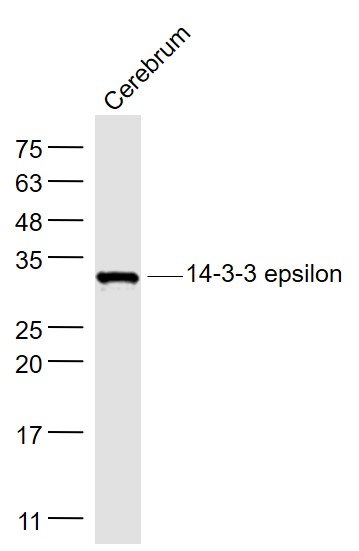
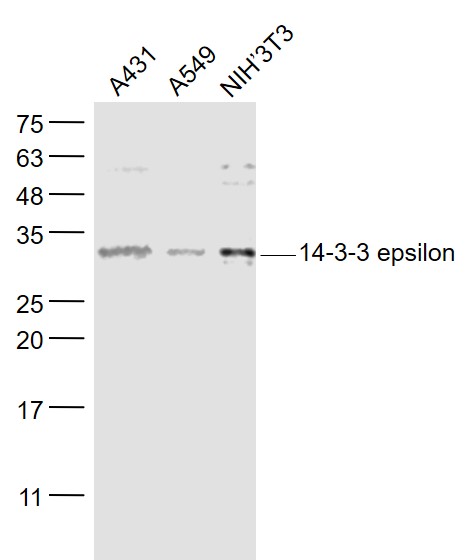

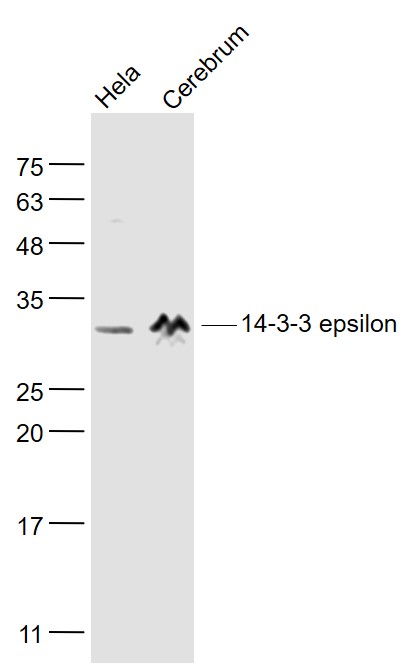
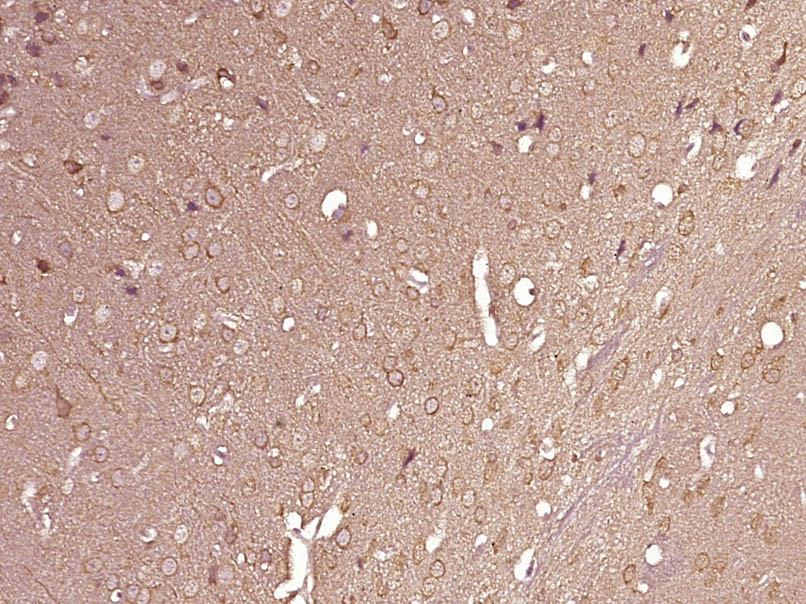
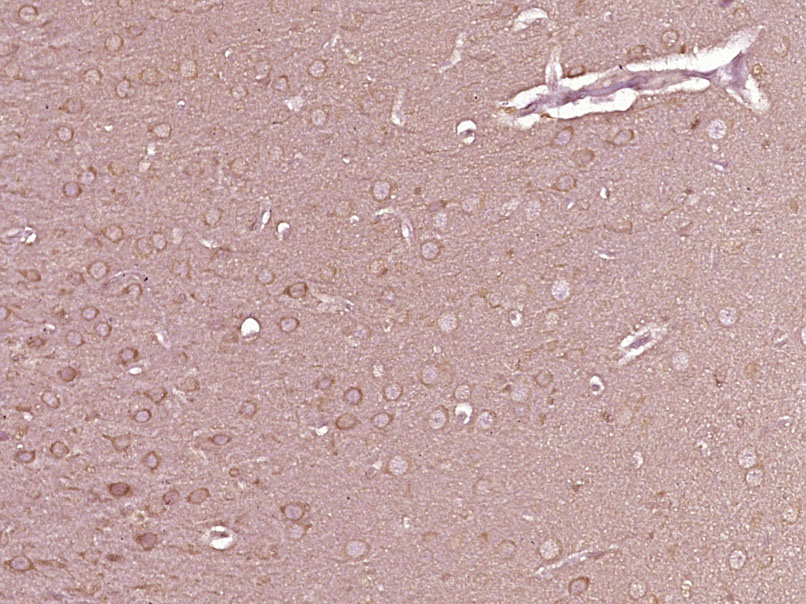
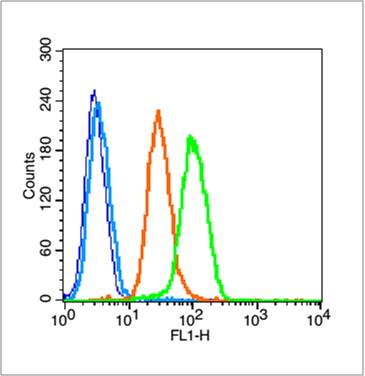


 +86 571 56623320
+86 571 56623320




